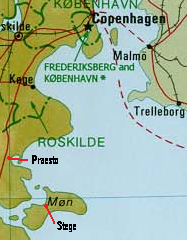
 The map at left shows the proximity of Stege to Copenhagen, roughly 70 miles.
The map at left shows the proximity of Stege to Copenhagen, roughly 70 miles.
 I found these "Coats of Arms" on Designs of Wonder.
I found these "Coats of Arms" on Designs of Wonder.

 The map at left shows the proximity of Stege to Copenhagen, roughly 70 miles.
The map at left shows the proximity of Stege to Copenhagen, roughly 70 miles.
This concise article on the history of Møn, mentions a merchant named Meyers, in Stege, that became churchwarden, in 1793. Perhaps his family had some influence on Christain Nelson and his son Frank Meyers Nelson, since Meyers was used as a middle name for a few generations. There is reference to a Meyers owning a ship building yard near Copenhagen.
In the documents published about Christian's son, Frank, it is noted that Christian was a steamship engineer, and died in Valparaiso Chile, around 1863, of yellow fever. The Pacific Steam Navigation Company (PSNC) was based in Valparaiso Chile, and Liverpool England. If Christian's wife received notification, of her husband's death, from Valpariaso, that would lend credence to his having worked for the PSNC.
It appears that these old time sailors could walk out on the dock and get employment on just about any ship preparing to sail. Christian could have bounced between any number of ships, and therfore employers. Perhaps he started out as a dock worker, loading and unloading ships, then possibly found his first work as a sailor, on a ship from any number of nationalities, that hauled cargo to, or from Copenhagen. Then at another port he could have found employment to any number of "exotic" destinations, and finally, to the Americas. My first assumption will be that he worked for an English company. The English controlled more the 50% of ocean going freight in 1850, so they are going to need the most men.
An article by the Merchant Navy Association gives this information. In 1835, the Chilean Government granted William Wheelwright, an American living in Valparaiso, exclusive rights to operate steamships in their waters. This lead to the founding, in 1838, of the PSNC. From 1840 to 1914 this company ran ships around the southern tip of South America, through the Straights of Magellan, rather than around Cape Horn.
In 1848 an overland route was opened in Panama, but it wasn't until 1854 that a railway was built, and heavier freight could receive the same 40 day journey, from Valparaiso to Liverpool, that the mail had seen, since 1846. However the operators of the railroad charged the PSNC higher rates than "American" companies, so the PSNC continued to use the southern route, from Valparaiso to Liverpool.
Early ports of call were Valparaíso, Coquimbo, Huasco, Copiapó, Cobija, Iquique, Arica, Islay, Pisco, and Callao. In 1846 the route expanded to include Huanchaco, Lambayeque, Paita, Guayaquil, Buenaventura, and Panama City. Then again, in 1848 the routes grew to include Puerto Montt, and overland, to Colon, Panama. In 1860 the Pacific Steam Navigation Company had 12 ships covering the west coast of Chile. The map at right shows the ports of call, and routes in red
This site also has a list of ship wrecks for the PSNC. The ship LIMA was lost on July 11 1863. Now if I can find a crew list........but family tradition is that he died of yellow fever.
By 1865 the PSNC expanded to include a route, starting in Liverpool, through, Bordeaux, Lisbon, Cape Verde Is, Rio de Janerio, Montevideo, Punta Arenas, to Valparaiso, and back. My ancestor should have been dead before this, however.
In an 1870 article The Ocean Steamer - Crossing the Atlantic in Early Steamships - 1870 there is an interesting paragraph. It states that ships steamed to to the Isthmus of Darien, where they connected, through the Isthmus, with shipping from the Pacific side of the Americas. Up to 8 ships a day left the Copenhagen Port.
It wasn't until the mid 1870s that PSNC had any competition, on the west coast of South America.
The first transAtlantic cable was laid between 1857 and 1866, it ran between Ireland and Newfoundland. Additional cables were laid until 1894, but this would not have put Christian on the west coast of South America.
In the 1880 the French made the first attempt to dig the Panama Canal. 21,900 people died in that effort, mostly from yellow fever and malaria. The Panama Canal finally opened for service in 1914.
Christen Nielsen, age 37 married Anne Kirstine Pedersdatter, age 28 on 17 Oct 1858 in Kobenhavn, Kobenhavn, Denmark. This is kind of tight to have left 4 children. With 41+ months of marriage, working around a sailors schedule.
Using their ages at marriage this information has been extrapolated.
Christen Nielsen, born 3 Jan 1821, christened the same day in Kastrup, Praesto, Denmark. His parents were, Father - Niels Christensen, Mother - Karen Jensdatter.
From the 2 versions of his biography below his mother has both Christina and Anna as names, which helps add credence to this line of thinking.
Anne Kirstine Pedersdr, born 18 Jun 1830, christened 29 Aug 1830 in Kalvehave, Praesto, Denmark. Her parents were, Father - Peder Frandsen, Mother - Sidse Boesdatter.
Another of Frank and Rachel's descendants scanned this old photograph. It is pretty amazing how much information is stashed away by descendants of the early pioneers. Below, Frank is seated in the center. We have no identification for the man to the right. Rachel is holding Jeane, and Frank Alexander is on the wooden pony.
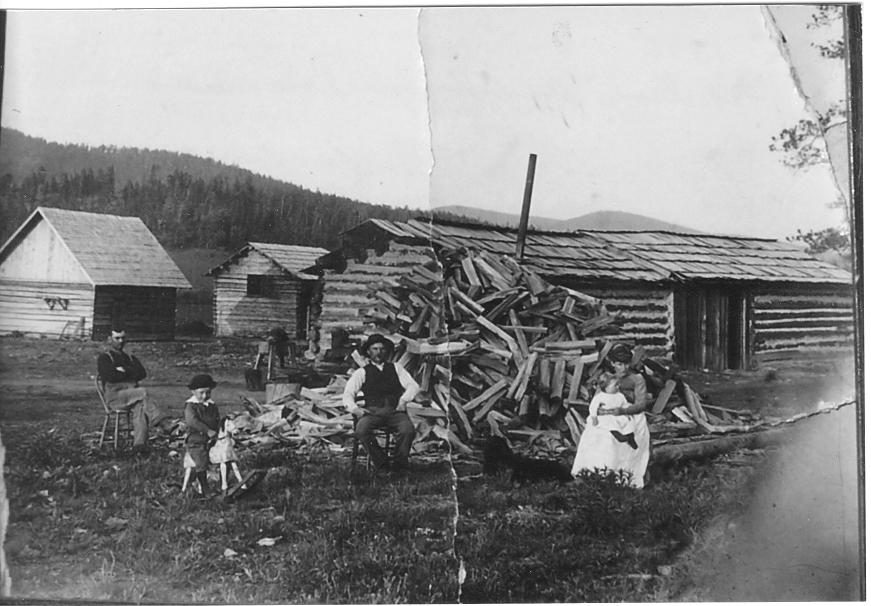
The articles below are pulled from old newspapers and books. I have added the pictures and their descriptions.
The following article is from the book: .
 Left, Frank and Rachel at the Potomac homestead.
Left, Frank and Rachel at the Potomac homestead.
FRANK NELSON.--Many of the sturdy sons of the fair Norseland have cast in their lot with Montana, identified themselves with its industrial life and attained marked success by reason of their consecutive industry and honest and upright lives. Mr. Nelson is one of the enterprising and prosperous farmers and stockgrowers of Missoula county, and is worthy of representation in this work. He was born in Denmark in 1862, the son of Christian and Christina (Petersen) Nelson, both representatives of long lines of Danish ancestors. The father was a steamboat engineer, and went to South America to follow his vocation, and there his death occurred in 1863. His widow remained in her native land, where her death occurred in 1877.
Frank Nelson secured a common school education and resided in his native land until the death of his mother, and in 1878 he emigrated to America, and to Iowa, where he was employed in a railroad roundhouse at Council Bluffs for a year and a half, when he again turned his face westward, coming to Idaho, where he worked in the mining districts for three years, being for some time in Coeur d' Alene country and thence coming to Drummond, Montana, where he was employed in the mines for three years. His next move, in 1885, was one which he has never had cause to regret, for he came to Missoula county and entered claim to his present ranch on Camas prairie, where he has since maintained his home. Here he owns a tract of 780 acres, upon which he has made the best of improvements, and he devotes his attention to general farming and stock growing, raising large crops of hay and grain and having a high grade of livestock. The ranch is eligibly located three miles west of Potomac, which is Mr. Nelson's post office address. In 1887 Mr. Nelson was married to Miss Rachel Lish, who was born in California, and they have three children, Frank A., Jennie E., and Bert M., The children are attending school, and all are making fine progress, showing deep interest in their studies. In politics Mr. Nelson gives his support to the Democratic party, and he lends his aid to all undertakings that make for the advancement and well-being of his county and state.
 Right, the Potomac homestead
Right, the Potomac homestead
FRANK NELSON was born in the kingdom of Denmark on April 7, 1862. His father, Christian Nelson, was a steampship engineer, who "sailed the seas over from here to Peru." However, his son Frank did not acquire his wanderlust from hearing the fascinating tales of strange men and customs, for the father died in Valparaiso of the yellow fever before his son was born, and the lad grew up under the care of his mother, Anna Peterson Nelson. He was early obliged to shift for himself, and his schooling was obtained in Denmark, before he reached the age of fourteen. At that age, he came to America to seek the fortune which he has found, or rather created. Council Bluffs, Iowa was his first abiding place in America, and he remained here for four years. In 1880, he came to Idaho and for three years was a veritable soldier of fortune. He rode the range and worked at anything he could find to do.
It was in 1883 that Mr. Nelson first came to Missoula, but he did not succeed in finding employment and so he went to Drummond. Here he obtained work on the John Edwards ranch, and he helped the proprietor of that place to build the first house in Drummond. For a time he drove the stage for Bill Hammond from Drummond to Philipsburg. In 1884, Mr. Nelson located a claim on the Big Black Foot in the Potomac valley, and three years later he sold this and bought another ranch in the same region. He has added to this until now it contains 1,420 acres and his cultivation of it, coupled with the settling up of the valley has converted it into a most valuable piece of property. It was about this time that placer mining was being carried in so extensively in various sections of Montana, and in 1885, Mr. Nelson engaged in this at Elk Creek and devoted something like a year to it.
For a number of years, Mr. Nelson has conducted an extensive implement and carriage establishment. He also handled wagons and automobiles, and his plant is the largest of the kind in this section of the country. Although this business is a notably successful one, Mr. Nelson does not intend to continue in it, as he wishes to move to his extensive ranch and to devote his entire energies to the management of that.
Politically, Mr. Nelson is aligned with the Democrats, and he is a person of influence and wide popularity in his party. In 1904, they selected him as their candidate for the legislature, and he is now seving his third year as county commissioner, to which office he was elected in 1908 for a term of six years. As a public officer, his record is one of conscientious and public-spirited devotion to the interests of this community.
The boy of fourteen who came to this country not even knowing the language has become a wealthy and a respected citizen; a public officer in the country of his adoption. His success is of his own making and one of which he may justly be proud. However, it is not his own achievements which inspire Mr. Nelson to that emotion so much as the fine family which he and his wife have brought up. Frank and Rachel Lish Nelson were married December 27, 1886, and they have a family of five children. These are Franklin A., born February 4, 1888; Jennie Anna, whose birthday was December 6, 1889; Bert M., August 7, 1891; Theodore W. and Howard E. both born in February, the former in 1902, and the latter eight years later. Mrs. Nelson was born in San Bernardino, California, but her union with Mr. Nelson occurred in Philipsburg, Montana. Mr. Nelson is of the opinion that his wife has been a partner in his success and a most valuable one from every standpoint. In this opinion, all who know Mrs. Nelson concur with her husband. He is one of the substantial citizens of the community, an active factor in its prosperity, and in every way representative of the things for which the county is proud to stand.
 Left, The Higgins street bridge washes away in the flood of 1908.
Left, The Higgins street bridge washes away in the flood of 1908.
Missoula, March 14 -- Sale of the huge Frank Nelson cattle ranch in the Blackfoot Valley was recorded in the county clerk's office yesterday. W.K. Wills of Baird was the purchasher, the price paid not being stated in the transfer articles. The former owner is among the most prominent of the citizens of the county, having been a member of the county, having been a member of the state legislature and being a leader in political circles. Mr. Wills is a cattleman, whose residence is on the main highway at Baird, east of here.
Two and one-fourth sections of land, comprising 1,680 acres, is the size of the ranch.
Mr. Wills gave a mortgage to the Missoula Mercantile company for $20,000 payable in 10 years and bearing six per cent annual interest.
Mr. Nelson purchased the ranch from August Paulson in 1925, the purchase price being $34,000.
THE DAILY MISSOULIAN printed this article on March 18, 1928..
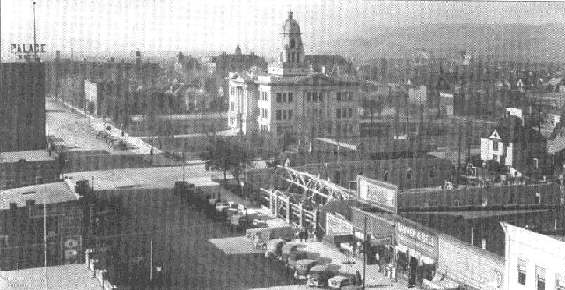 Right, Missoula County Courthouse circa 1920.
Right, Missoula County Courthouse circa 1920.
Frank Nelson, for 44 years a rancher up the Blackfoot Valley, has retired and moved to Missoula to make his home.
During the time Mr. Nelson lived in the Blackfoot he was one of the best known men of Missoula county. He first went to the Potomac Valley in 1884 when the only way to get there was from a trail over the range of the Bearmouth. "when I went to the valley," Mr. Nelson said, "a young fellow by the name of William Walsh went with me. We bought the squatter's rights of a man named Gage".
"Walsh stayed on the place and I started to work for wages. I worked in placer mines on Elk Creek and at Yreka and Ranald City for two summers. In the spring of 1886 I bought Walsh out. Then in the spring of 1887 I sold my squatter's rights to Pat Hayes. It is still the Hayes Ranch".
In the summer of 1887 Mr Nelson teamed at Philipsburg. In the fall of 1887 he came
back to the Blackfoot and located on the ranch which has since been his home, and which
he has just disposed of..
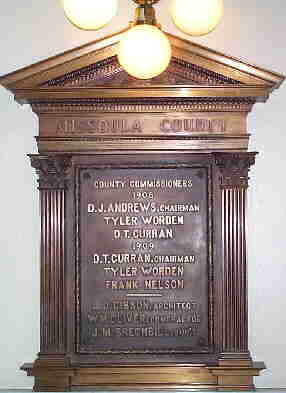
He had been on the ranch for 40 years, although the valley had been his home continuously for 44 years. Hay, cattle, and horses took up the ranch activities during that period and Mr. Nelson had 1,400 acres of land when he disposed of the place. He said yesterday that at one time he had 180 head of cattle on the place.
At left is the plaque that hangs in the Missoula County Courthouse.
Mr. Nelson saw the building of the first of the roads into the Potomac Valley. As stated, the first trail into that country was over the range from Bearmouth. The first road was built by Clinton in 1885, and in 1886 the road was built up the valley from Bonner to Potomac.
During his residence in the
country, Mr. Nelson served as a member of the county board of commissioners
and in the state legislature. He is at present a member the
Always active in politics, Mr. Nelson was elected to
membership on the board of county commisioners in 1908 and served until 1914.
"Among the things I accomplished during the time I was on the board" Mr.
Nelson said
Mr. Nelson served in the 18th session of the state legislature. In speaking of his legislative activities, Mr. Nelson said, "I was author of the city and county consolidation bill, now a law. I was author of the amendment to the to the primary bill in which the manner of filing for office was changed so that the candidate in going into the primary paid a filing fee instead of the circulation of petitions. Through the change $56,000 in filing fees was c collected by the counties and the state during its first year of operation of the law. This went a long way toward helping out the counties on election expense."
Mr. Nelson was born in Denmark, on the island Moen in 1862. His
father, a steamboat engineer, died in Valpariso with the yellow fever when
Frank was an infant. He left a family of four children, and Frank was the
youngest.
He started to work for himself when he was 8 years old. When 14 he came to the United States and located in Council Bluffs, Iowa. There he worked on farms and also in in the railroad roundhouse. While employed in the roundhouse he wiped the first engine that ever went into Council Bluffs.
In the spring of 1880 he came to Idaho and worked on cattle ranches around Pocatello.
 In the fall of 1883 he started to the Coeur d' Alene
district on account of the gold excitement. He got only only to Heron siding
when it was learned that the trail from the present Sanders county over the
range into the Couer d' Alenes was blocked by snow; so he returned to Missoula,.
After a few weeks here he went to Drummond, worked on ranches, and drove the
stage from Drummond to Philipburg, Leaving that work he first went into the
Blackfoot in 1884.
In the fall of 1883 he started to the Coeur d' Alene
district on account of the gold excitement. He got only only to Heron siding
when it was learned that the trail from the present Sanders county over the
range into the Couer d' Alenes was blocked by snow; so he returned to Missoula,.
After a few weeks here he went to Drummond, worked on ranches, and drove the
stage from Drummond to Philipburg, Leaving that work he first went into the
Blackfoot in 1884.
In 1886 Mr. Nelson was married to Rachel Lish. They have five children: Frank A., junior, connected with the Indian Services on the Crow reservation; Bert Nelson a rancher at St. Ignatius; Teddie Nelson in California, Howard, now attending high school here; and a daughter Mrs. Strong (Jeane), wife of the district judge at Billings. The Nelson family is located at 401 Beckwith avenue.
The old Nelson ranch will be run by W.W. Wills of Baird, who has purchased it.
Left, Frank and Rachel's head stone.
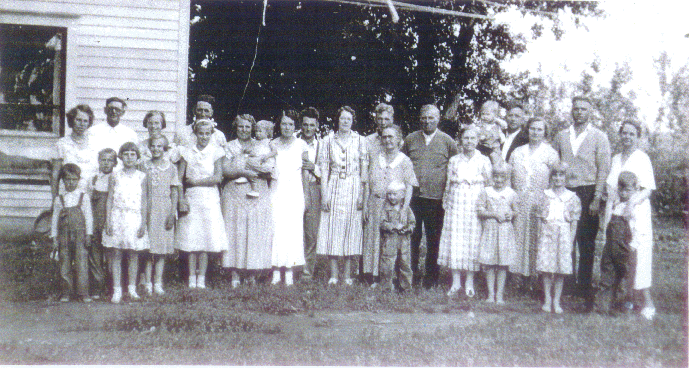 This picture would have been taken about 1935, since the baby is Phylis Nelson born in 1934.
The woman, sixth from the left, in the front row, holding the baby, is KEPHART. Just behind her at forth from the left is, her husband, Bert NELSON. Fifth from the right side of the picture wearing a plaid dress is Martha Jane SKAGGS.
This picture would have been taken about 1935, since the baby is Phylis Nelson born in 1934.
The woman, sixth from the left, in the front row, holding the baby, is KEPHART. Just behind her at forth from the left is, her husband, Bert NELSON. Fifth from the right side of the picture wearing a plaid dress is Martha Jane SKAGGS.
 Wilma Nelson is on the right end of this lineup.
Wilma Nelson is on the right end of this lineup.
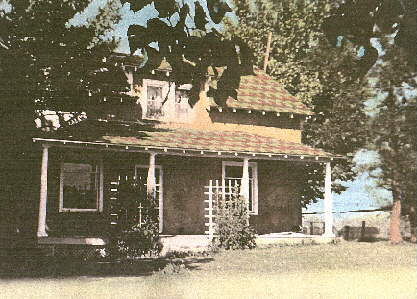 Nelson home on Post Creek hill.
Nelson home on Post Creek hill.
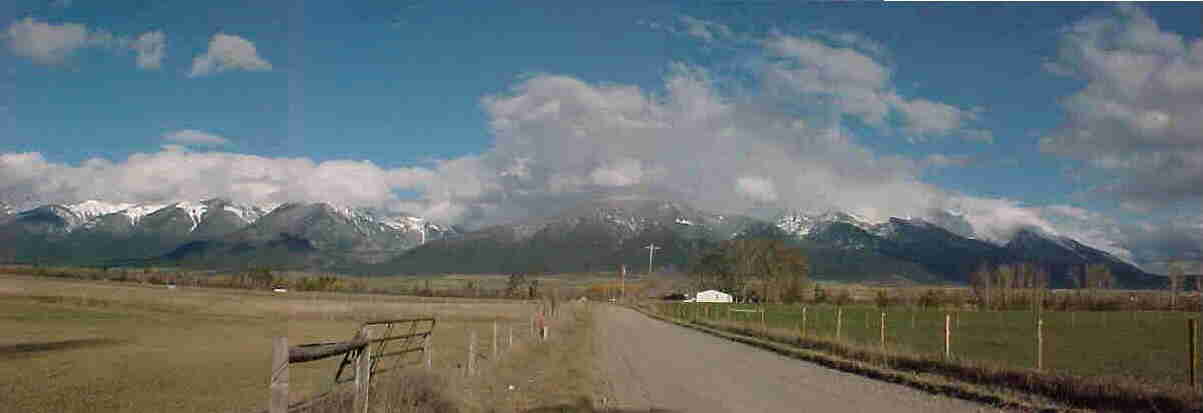 View looking east on Post Creek road near to Nelson Family home. This is a composite of 3 photos.
View looking east on Post Creek road near to Nelson Family home. This is a composite of 3 photos.
 Philip Bert Nelson was born 31 March 1918 (on Easter Sunday) in Polson, Montana. He was
the fourth child born to Bert and Vesta Leona Nelson. He was raised on a farm near St.
Ignatius by Post Creek. He remembers doing something when he was a little boy for which
he knew his Mom would spank him. He ran into the center of a large puddle, thinking he
would be safe there.
Philip Bert Nelson was born 31 March 1918 (on Easter Sunday) in Polson, Montana. He was
the fourth child born to Bert and Vesta Leona Nelson. He was raised on a farm near St.
Ignatius by Post Creek. He remembers doing something when he was a little boy for which
he knew his Mom would spank him. He ran into the center of a large puddle, thinking he
would be safe there. To his surprise his mother waded in after him, and he got the spanking. He attended Hillside Elementary School, completed the requirements, and was given a graduation certificate on May 28, 1932. He attended St. Ignatius High School and graduated in May 1936.
He married Gladys Harris on 13 February 1937. They had six children: Kay, Zoe, Bert, Lee, Gaye and Rodney.
He worked on the family farm until it was sold in 1945. He then worked as a farm manager for Dr. Teal who had a farm that bordered on Flathead Lake near Polson. Later he bought 40 acres of land in St. Ignatius near Post Creek. In addition to farming, he did a milk run to pick up cans of milk from the local dairy men to help with needed income. He did have many backaches and problems from hoisting the cans of milk onto the truck. While living at Post Creek they acquired a 10 party telephone line, indoor plumbing, and an electric stove. The original stove was a wood burning stove with a water reservoir on the side to heat water for bathing, and other household needs. They had a wringer clothes washing machine (clothes were run through the wringer to remove the water). They eventually bought a TV set. The children thought the TV was interesting, but actually preferred playing outside to watching TV. They raised a good portion of their own food with a large garden, orchard, chickens, and cattle. In the early 1950's Philip had a heart attack. Gladys went to work at Beckwith's store to help with needed income, and the kids tried to keep up with work at home and go to school. Kay cooked the meals, Zoe did the washing and ironing, and Bert and Lee milked the cows, brought in wood for the stoves, and took care of the other outside chores. Gaye and Rodney were to small for assigned chores.
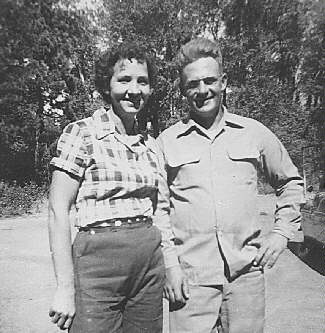 After Philip recooperated sufficiently from his heart attack, he joined his brothers in a
logging business venture. They called the business NELSON BROTHERS LOGGING COMPANY.
After Philip recooperated sufficiently from his heart attack, he joined his brothers in a
logging business venture. They called the business NELSON BROTHERS LOGGING COMPANY.
He sold his property near St. Ignatius and bought a home in Missoula at 604 S 5th E near the University of Montana.
Later the city of Missoula wanted to demolish the house on 5th street to make way for a proposed to cross the Clark Fork River (Van Buren Street Bridge). Philip thought the offer to buy out his property was too low, and refused the offer. They condemned his property, and gave him the original offered price. Nelson Brothers Logging Company was having financial trouble, and since his house was going to be demolished, he chose to move to Washington near Mesa, where his brother Allen had already purchased land. Philip bought 150 acres. The land was being sold at a good price, well it was actually desert. After years of improvements they were able to make the land productive.
While attending a dance in 1964 he suffered a massive, fatal heart attack. He is buried in Pasco, Washington.
His son, Lee, took over the family farm. At right Gladys and Philip Nelson.
Below are 3 pictures from the Nelson Brothers Logging Company, taken February 28, 1955.

Above is a Bucyrus-Erie heel boom loading a truck. The heel boom was powered by a Caterpillar D318.

A caterpiller D8 equiped with a Hyster Hyspeed winch is used to skid logs to a landing.


 Nelson family members.
Nelson family members.